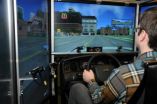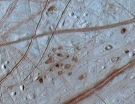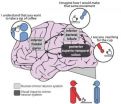(Press-News.org) BOSTON (March 14, 2014) — A diagnosis of hemianopia, or blindness in one half of the visual field in both eyes as the result of strokes, tumors or trauma often means the end of driving.
In about half of the states in the United States and in many other countries, driving with hemianopia is prohibited. However, in some countries including Belgium, the Netherlands, the UK, Switzerland and Canada, driving with hemianopia is permitted after passing a specialized road test. Researchers at Massachusetts Eye and Ear/Schepens Eye Research Institute set out to determine the extent to which people with hemianopia can compensate for the lost vision when driving, with a long term goal of developing and evaluating devices and training that will assist them to drive more safely.
People with hemianopia have to look (scan) with eye and/or head movements toward the side of the field loss in order to see obstacles or hazards on that side. "The wide field of view that needs to be scanned at intersections presents an especially challenging situation for drivers with hemianopia as they have to scan larger angles than drivers with a full field of vision in order to see all of the intersection on the side of the field loss," said lead author Alex Bowers, Ph.D.
Bowers and colleagues used a driving simulator to evaluate head scanning behaviors of 14 drivers with hemianopia and 12 drivers with normal vision as they approached intersections. Their results are described in the March 12 issue of Investigative Ophthalmology & Visual Science in the paper: Driving with Hemianopia: IV. Head Scanning and Detection at Intersections in a Simulator.
"We found that participants with hemianopia showed compensatory scanning patterns in that their first scan was usually to the side of their field loss. Drivers with right hemianopia tended to look to the right before looking to the left. By comparison, the normally sighted drivers and drivers with left hemianopia typically looked to the left first," Bowers said.
However, the drivers with hemianopia did not compensate by making larger head scans to the side of their field loss, as needed. In fact, their head scans were generally smaller than those of drivers with normal vision. "Yet, you might have expected the opposite as drivers with hemianopia have to scan a long way (close to 90 degrees) in order to see of all of the intersection on the side of their field loss," Bowers said.
Drivers with hemianopia, especially drivers with right hemianopia, had low detection rates for pedestrians that appeared on the side of their field loss. Analyses of the head scans at these intersections revealed that the detection failures were either because the driver never scanned to the side of their field loss, or because they scanned, but not far enough, Bowers said.
"We might have expected that drivers with hemianopia would have had lower rates of failing to scan than drivers with normal vision, but this wasn't the case," Bowers said.
The findings suggest that, although there is evidence of compensation for the hemifield loss in some aspects of their scanning at intersections, the scanning patterns employed by some drivers with hemianopia may be insufficient for safe driving. Based on these individual responses, some drivers might benefit from training tailored to the specific problem areas identified in the study, Bowers noted.
She went on to summarize, "Our results underscore the importance of individualized evaluations for people with hemianopia who wish to resume driving. While some of the participants in our study frequently did not head scan to the side of their field loss, others always scanned to that side. Individualized assessments are an important component of the special provisions (regulations) that enable drivers with visual field loss to demonstrate their ability to drive safely in specialized road tests in other countries."
INFORMATION:
This research was supported by National Institutes of Health Grants EY12890 and EY018680. Authors included Alex R. Bowers, Egor Ananyev, Aaron J. Mandel, Robert B. Goldstein and Eli Peli, of Mass. Eye and Ear/Schepens Eye Research Institute and Harvard Medical School.
About Massachusetts Eye and Ear
Mass. Eye and Ear clinicians and scientists are driven by a mission to find cures for blindness, deafness and diseases of the head and neck. Led by the Eaton-Peabody Laboratory in Otology, the Howe Laboratory in Ophthalmology and Schepens Eye Research Institute, Mass. Eye and Ear in Boston is the world's largest vision and hearing research center, offering hope and healing to patients everywhere through discovery and innovation. Mass. Eye and Ear is a Harvard Medical School teaching hospital and trains future medical leaders in ophthalmology and otolaryngology, through residency as well as clinical and research fellowships. Internationally acclaimed since its founding in 1824, Mass. Eye and Ear employs full-time, board-certified physicians who offer high-quality and affordable specialty care that ranges from the routine to the very complex. U.S. News & World Report's "Best Hospitals Survey" has consistently ranked the Mass. Eye and Ear Departments of Otolaryngology and Ophthalmology as among the top hospitals in the nation.
Drivers with hemianopia fail to detect pedestrians
Driving simulator used to help learn how the visually impaired can drive safely
2014-03-14
ELSE PRESS RELEASES FROM THIS DATE:
New findings show link between diabetes and pancreatic cancer
2014-03-14
In a new study published today in Annals of Surgical Oncology, clinicians worked with mathematicians to review data from 1973 to 2013 to conclude there was a time-dependent link between being diagnosed with diabetes and pancreatic cancer.
A review of 88 international studies to date, is the largest analysis on the topic published.
Dr Mehrdad Nikfarjam, liver, pancreas and biliary specialist from the Department of Surgery at the University of Melbourne said pancreatic cancer was often diagnosed when at an advanced, incurable stage.
"This is an important paper that ...
New stratigraphic research makes Little Foot the oldest complete Australopithecus
2014-03-14
After 13 years of meticulous excavation of the nearly complete skeleton of the Australopithecus fossil named Little Foot, South African and French scientists have now convincingly shown that it is probably around 3 million years old.
In a paper published today, Friday, 14 March 2014 at 12:00 (SATS), in the scientific journal, the Journal of Human Evolution, the latest findings by Professor Ron Clarke from the University of the Witwatersrand and his colleagues refute previous dating claims that suggested Little Foot is younger. (See the all authors' details and affiliations ...
New knowledge: Blood poisoning increases the risk of blood clots
2014-03-14
Every year, almost 10,000 Danes are admitted to hospital with blood poisoning, while more than 3,000 patients become infected while they are hospitalised. New research shows that Danes suffering from blood poisoning risk an extra challenge in the form of an increased risk of suffering a blood clot:
"We have followed more than 4,000 people who have been admitted with blood poisoning. The study shows that the risk of suffering a blood clot in either the brain or the heart is twice as high for patients with blood poisoning in relation to other patients who are also admitted ...
An experiment recreates the crust of the moon Europa
2014-03-14
Water, salts and gases dissolved in the huge ocean that scientists believe could exist below Europa´s icy crust can rise to the surface generating the enigmatic geological formations associated to red-tinged materials that can be seen on this Jupiter's satellite. This is confirmed by the experiment carried out in the laboratory with water, carbon dioxide and magnesium sulfate by researchers at Centro de Astrobiología (CAB, Spain).
Scientists suspect that inside Europa, one of the icy moons of Jupiter, reservoirs of liquid water exists, the essential element for life on ...
Number of days without rain to dramatically increase in some world regions
2014-03-14
By the end of the 21st century, some parts of the world can expect as many as 30 more days a year without precipitation, according to a new study by Scripps Institution of Oceanography, UC San Diego researchers.
Ongoing climate change caused by human influences will alter the nature of how rain and snow falls; areas that are prone to dry conditions will receive their precipitation in narrower windows of time. Computer model projections of future conditions analyzed by the Scripps team indicate that regions such as the Amazon, Central America, Indonesia, and all Mediterranean ...
Brain mapping confirms patients with schizophrenia have impaired ability to imitate
2014-03-14
According to George Bernard Shaw, "Imitation is not just the sincerest form of flattery – it's the sincerest form of learning." According to psychologists, imitation is something that we all do whenever we learn a new skill, whether it is dancing or how to behave in specific social situations.
Now, the results of a brain-mapping experiment conducted by a team of neuroscientists at Vanderbilt University strengthen the theory that an impaired ability to imitate may underlie the profound and enduring difficulty with social interactions that characterize schizophrenia. In ...
Deceased trust beneficiary's share held payable to his estate
2014-03-14
Deceased trust beneficiary's share held payable to his estate
Article provided by Teague & Wetsel, PLLC
Visit us at http://www.teaguewetsel.com/
In the case of Estate of Rozell v. Betty Rozell Revocable Trust, the Oklahoma Court of Civil Appeals reviewed the language of a revocable trust and ruled, in a divided opinion, that the share designated for a deceased beneficiary who died without children was fully vested and payable to his estate.
Background of the case
In 2002, the decedent's mother signed a revocable trust agreement. The trust agreement contained ...
Non-suspect victim attacked by police dog could proceed with lawsuit
2014-03-14
Non-suspect victim attacked by police dog could proceed with lawsuit
Article provided by Day, Day & Brown
Visit us at http://www.daydayandbrown.com
If you are attacked by a neighbor's dog, you might expect that the neighbor would be responsible for your resulting personal injuries. However, what if you were randomly attacked by a police dog, through no fault of your own? Might you still deserve compensation for your dog bite injuries?
The California Court of Appeal recently discussed such a case in Pulido v. Reaver.
A police dog attacks
The victim was ...
Probation sentencing for intoxication manslaughter convictions
2014-03-14
Probation sentencing for intoxication manslaughter convictions
Article provided by Law Office of Paul Schiffer
Visit us at http://www.schifferlawfirm.com
A unique offense
DWI (driving while intoxicated) is a serious offense with serious, potentially long lasting, consequences. A criminal record of a DWI conviction may affect your future employment prospects, not to mention, your personal freedom.
While each state has DWI laws, each state has variations in the ways they classify such offenses, both in terms of the legal requirements for convictions and in the ...
Do not be a victim of misdiagnosed heart failure
2014-03-14
Do not be a victim of misdiagnosed heart failure
Article provided by Webb & Beecher
Visit us at http://www.bestmilitarymedicalmalpracticelawyer.com
Many people claim to know that they would recognize the symptoms of a heart attack if they or a loved one is afflicted. However, even medical professionals fail to diagnose heart disease with their own patients, causing or allowing harm to the people they are sworn to protect.
Late last year, results of a study conducted by the medical journal JAMA revealed that more than a third of people suffering from acute ...
LAST 30 PRESS RELEASES:
Tracing the quick synthesis of an industrially important catalyst
New software sheds light on cancer’s hidden genetic networks
UT Health San Antonio awarded $3 million in CPRIT grants to bolster cancer research and prevention efforts in South Texas
Third symposium spotlights global challenge of new contaminants in China’s fight against pollution
From straw to soil harmony: International team reveals how biochar supercharges carbon-smart farming
Myeloma: How AI is redrawing the map of cancer care
Manhattan E. Charurat, Ph.D., MHS invested as the Homer and Martha Gudelsky Distinguished Professor in Medicine at the University of Maryland School of Medicine
Insilico Medicine’s Pharma.AI Q4 Winter Launch Recap: Revolutionizing drug discovery with cutting-edge AI innovations, accelerating the path to pharmaceutical superintelligence
Nanoplastics have diet-dependent impacts on digestive system health
Brain neuron death occurs throughout life and increases with age, a natural human protein drug may halt neuron death in Alzheimer’s disease
SPIE and CLP announce the recipients of the 2025 Advanced Photonics Young Innovator Award
Lessons from the Caldor Fire’s Christmas Valley ‘Miracle’
Ant societies rose by trading individual protection for collective power
Research reveals how ancient viral DNA shapes early embryonic development
A molecular gatekeeper that controls protein synthesis
New ‘cloaking device’ concept to shield sensitive tech from magnetic fields
Researchers show impact of mountain building and climate change on alpine biodiversity
Study models the transition from Neanderthals to modern humans in Europe
University of Phoenix College of Doctoral Studies releases white paper on AI-driven skilling to reduce burnout and restore worker autonomy
AIs fail at the game of visual “telephone”
The levers for a sustainable food system
Potential changes in US homelessness by ending federal support for housing first programs
Vulnerability of large language models to prompt injection when providing medical advice
Researchers develop new system for high-energy-density, long-life, multi-electron transfer bromine-based flow batteries
Ending federal support for housing first programs could increase U.S. homelessness by 5% in one year, new JAMA study finds
New research uncovers molecular ‘safety switch’ shielding cancers from immune attack
Bacteria resisting viral infection can still sink carbon to ocean floor
Younger biological age may increase depression risk in older women during COVID-19
Bharat Innovates 2026 National Basecamp Showcases India’s Most Promising Deep-Tech Ventures
Here’s what determines whether your income level rises or falls
[Press-News.org] Drivers with hemianopia fail to detect pedestriansDriving simulator used to help learn how the visually impaired can drive safely


